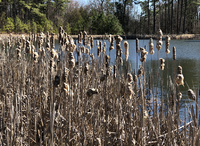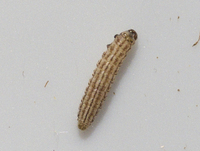Identification
Adult Markings: This is a rather distinctive small moth that has a streamlined tan body and two black discal dots in the gray streak that are ringed with white. The following detailed description is based on those by Forbes (1923) and Powell and Opler (2009). The adults are slender and the head, thorax, and ground of the forewings are tan or clay-colored. The labial palps are thin, recurved, and diverging, and terminate above the thorax. Each has two slender black lines on the third segment. The antenna is about two-thirds the wing length. The shaft is cream-colored with a series of black dots that resemble annuli, and the scape has a black line. The forewing is uniformly tan or clay-colored, except for a faint to distinct longitudinal gray streak. There are two small, black, discal dots in the gray streak that are partially or completely ringed with white. There is also a weaker black point or dash just posterior and inward to the first discal dot. It often has a white margin on the posterior half. The fringe is pale gray, and the hindwing is light gray with a nearly white fringe.
Wingspan: 20 mm (Forbes, 1923)Forewing Length: 5.9-10.2 mm, with males smaller than females (Hodges, 1978)
Adult Structural Features: Hodges (1978) has descriptions and illustrations of the male and female genitalia.
Adult ID Requirements: Identifiable from good quality photos of unworn specimens.
Immatures and Development: The following life history summary is based on Claassen's (1921) work in New York. The larvae feed within the heads of cattails. They initially feed on the styles of the pistillate flowers, then move farther inward and eat the seeds of the plant. As cold weather approaches, they migrate still farther inward near the rachis. Silk is used to hold the downy material together and prevent the seeds from escaping. The cattail heads that are infested fluff out in large, conspicuous masses and are easily distinguished from non-infected heads. The larvae overwinter in the heads and resume growing during the spring. They either pupate within the head or bore into the stem where they form silk-lined burrows. Pupation occurs within tough, white cocoons and last about a month. The larvae are 10-12 mm long, and yellowish white with five longitudinal brown stripes. The median stripe is narrow, the next broader, and the lateral stripe is often broken into blotches. The head is light yellow and blotched with brown, and the prothoracic shield mottled with dark brown.
Larvae ID Requirements: Identifiable from good quality photos, especially where associated with known host plants.

 »
»




 »
»


